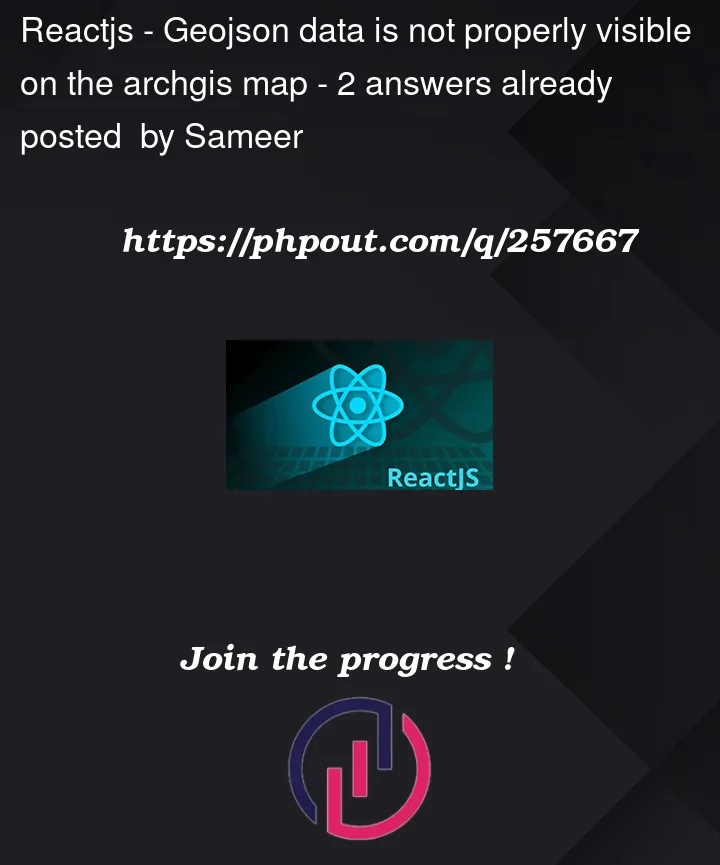I am trying to show Pakistan flood data on the ArcGIS map. the map is loading fine. Geojsos’ point is showing as well but when I click it, it doesn’t show any data. Can you please look into this? I feel there is an issue with the layers but unable to troubleshoot. Please look into this?
Here is my map component:
import React, { useRef, useEffect, useState } from 'react';
import { loadModules } from 'esri-loader';
const loadEsriModules = async () => {
const [MapView, WebMap, GeoJSONLayer] = await loadModules([
'esri/views/MapView',
'esri/WebMap',
'esri/layers/GeoJSONLayer',
]);
return { MapView, WebMap, GeoJSONLayer };
};
export default function PakFlood() {
const mapEI = useRef(null);
const [mapLoaded, setMapLoaded] = useState(false);
useEffect(() => {
const initMap = async () => {
if (mapLoaded) {
return; // Map has already been loaded, do not load again
}
const { MapView, WebMap, GeoJSONLayer } = await loadEsriModules();
let view;
if (typeof window !== 'undefined') {
const webmap = new WebMap({
basemap: 'topo-vector',
});
const centerCoordinates = [69.3451, 30.3753];
view = new MapView({
map: webmap,
center: centerCoordinates,
zoom: 5,
container: mapEI.current,
});
// Create a GeoJSONLayer using your GeoJSON data
const geojsonLayer = new GeoJSONLayer({
url: '/GeoJson.json', // Corrected URL path to your GeoJSON file
});
// Add the GeoJSON layer to the map
webmap.add(geojsonLayer);
setMapLoaded(true);
}
return () => {
if (view) {
view.destroy();
}
};
};
return () => initMap();
}, []);
return <div style={{ height: '400px', width: '100%' }} ref={mapEI}></div>;
}
my geojson file is:
{
"type": "FeatureCollection",
"features": [
{
"type": "Feature",
"properties": {
"Death": 336,
"Injuries": 106,
"Home Damaged": "4,26,897"
},
"geometry": {
"coordinates": [
67.02502796328298,
30.208618740113437
],
"type": "Point"
},
"id": 0
},
{
"type": "Feature",
"properties": {
"Death": 309,
"Injuries": 348,
"Home Damaged": "3,26,897"
},
"geometry": {
"coordinates": [
71.56406913421023,
34.166707649222474
],
"type": "Point"
}
},
{
"type": "Feature",
"properties": {
"Death": 799,
"Injuries": 8422,
"Home Damaged": "57,496"
},
"geometry": {
"coordinates": [
66.97593758543181,
25.004585896445533
],
"type": "Point"
}
},
{
"type": "Feature",
"properties": {
"Death": 23,
"Injuries": 8,
"Home Damaged": "1,160"
},
"geometry": {
"coordinates": [
74.31454667531628,
35.99794367334606
],
"type": "Point"
}
},
{
"type": "Feature",
"properties": { "Death": 223,
"Injuries": 3858,
"Home Damaged": "UNKNOWN"
},
"geometry": {
"coordinates": [
74.28116274467547,
31.745012657468934
],
"type": "Point"
}
}
]
}




2
Answers
Having recently finished a map project(only for Nuclear bombs), I feel your pain. To show data when you click a GeoJSON point, you’ll need to add a popup template to your GeoJSONLayer. A popup template defines the content displayed in a popup when a user clicks a feature.
Make sure you import the necessary modules from esri-loader.
Create Popup Template to show Death, Injuries, and Home Damaged.
Attach Popup to Layer: Attach the PopupTemplate to your GeoJSONLayer.
Add Layer to Map.
It’s tough to say without see the full code, but you can run some logs:
and tell me what they report, or if you figure it out from the logs, all good!